
AliMei’s Guide: What is the relationship between the currently popular 5G and edge computing, and where are their points of convergence? How do the IT domain of the Internet and the CT domain of telecommunications merge? What is cloud-network integration? Senior technical experts Nan Shu from Alibaba Damo Academy XG Lab and Yi Ping from the edge computing team share more possibilities of edge computing under 5G.
Benefits at the end of the article: Technical open class “Build Your Own Web IDE”.
1. The Core Capabilities of 5G Become the Biggest Driving Force for Mobile Edge Computing
The three major characteristics emphasized by 5G are its core capabilities: low latency, high bandwidth, and massive connectivity.
The promised low latency of 5G is 1 millisecond, but it should be emphasized that this 1 millisecond is only the air interface latency. For end users, what they may care more about is the end-to-end latency. The simplest calculation logic for end-to-end latency is distance; the latency caused by distance is essentially the fiber transmission latency, which is roughly 1 millisecond per 100 kilometers. Therefore, in the 5G era, the essence of end-to-end latency is the optical transmission delay caused by distance.
Using this perspective, we can compare it with the previous situations of 2G, 3G, and 4G. According to a test report from OpenSignal, during the 2G era, the fiber transmission latency was negligible in the overall end-to-end latency, meaning that the air interface latency accounted for the majority.
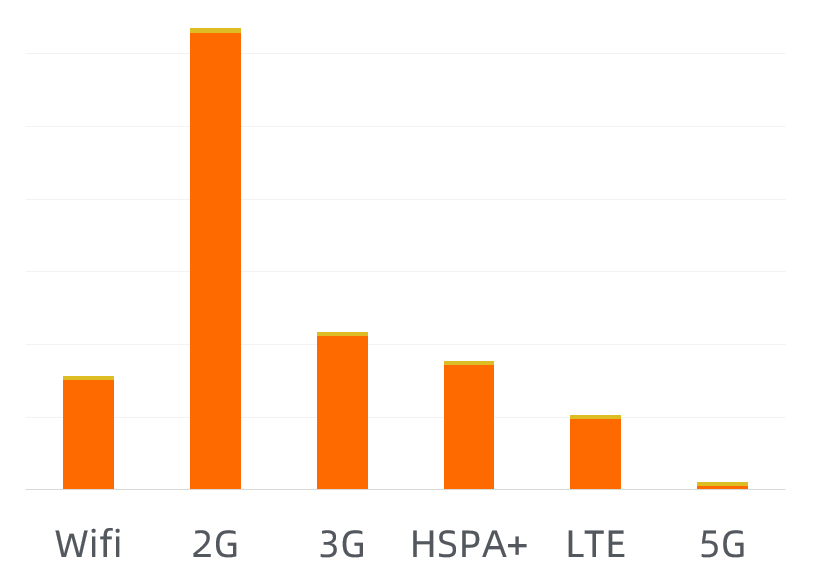
However, in the 5G era, this proportion reaches 60%. The geographical location of fiber transmission will greatly affect end-to-end latency, thereby impacting user experience. Therefore, to better leverage the low latency feature of 5G, it is necessary to deploy services closer to reduce the proportion of transmission in overall latency. The edge computing technology in the IT field can well meet this demand, becoming one of the driving forces for the development of mobile edge computing.
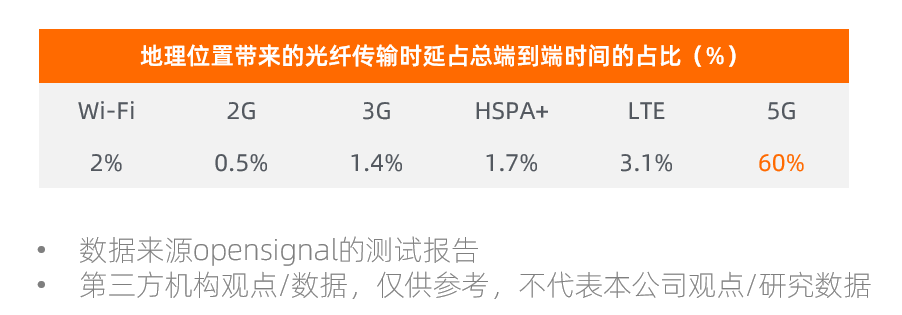
Another feature of 5G is high bandwidth. With peak rates of up to 10G, 5G allows users to see clearer videos and enjoy immersive business experiences. However, it also poses a challenge to traditional centralized cloud deployment methods, potentially increasing traffic costs by multiples for businesses, while also challenging the overall network bandwidth construction for operators. This requires us to reassess the network architecture and consider offloading traffic from centralized clouds to edge clouds. Here, we again find the convergence point between 5G and edge computing. By deploying services at the edge, we reduce the bandwidth consumption of the return link, lowering costs while also reducing latency.
In a standard IoT scenario, massive amounts of data can be generated. If all this data is centralized in the cloud for processing, it may lead to resource waste. By preprocessing data at an intermediate position, we can quickly provide downstream feedback, forming a closed loop for the IoT system. Additionally, we can perform upstream data aggregation, forming collective intelligence for the IoT.
This intermediate position is the deployment point for edge computing. Therefore, combining the analysis of the characteristics of 5G, which is the core capability of 5G, we can conclude that the core capabilities of 5G will become the biggest driving force for the development of mobile edge computing.

Edge computing can significantly reduce network latency.
2. IT+CT Integration of 5G Edge Computing
Thinking about edge computing under 5G merely from the perspective of resource proximity is too simplistic. Essentially, edge computing belongs to the Internet IT domain, while 5G belongs to the telecommunications CT (Communication Technology) domain. To effectively utilize edge computing under 5G, we must integrate IT and CT, rather than simply adding 1+1. This integration involves architectural integration, deployment integration, and scheduling integration.
Architectural Integration: Independent Standard Design Moving Towards Integrated Architectural Design
In terms of architectural integration, 5G includes UPF (User Plane Function) core network elements and system architecture supporting edge computing functions, which are planned within the 3GPP (3rd Generation Partnership Project) international organization. The overall architecture of edge computing, however, belongs to the ETSI (European Telecommunications Standards Institute), and both organizations are evolving independently in their own directions. Therefore, the first step is to integrate the architecture to form a unified, integrated architectural design.
Deployment Integration: Independent Dual-Lane Deployment Moving Towards Integrated Deployment
Deployment integration focuses on the deployment of UPF and MEC (Multi-access Edge Computing) nodes. UPF, as a network element of the mobile network, will be deployed by operators according to their plans, while MEC nodes belong to Internet companies, deployed according to their application scenarios and audience. Since they belong to different lanes, there may be inconsistencies in deployment, which can significantly reduce the benefits of edge computing. Therefore, we need to move from independent dual-lane deployment to integrated deployment. This also relates to the third integration, which is scheduling integration.
Scheduling Integration: Unaware Domain Scheduling Moving Towards Global Scheduling
Since the users served by UPF and MEC nodes are different, the traffic models of the two can vary significantly, and the network metrics required to support services are also different. To balance performance, capacity, cost, and service quality, both parties deploy their own independent scheduling systems. If these systems cannot be aware of each other, it will lead to inconsistencies in traffic direction, which not only diminishes scheduling effectiveness but may also lead to adverse outcomes. Therefore, we need to move from unaware domain scheduling to global scheduling.
In summary, the first consideration for edge computing in the 5G era is integration.
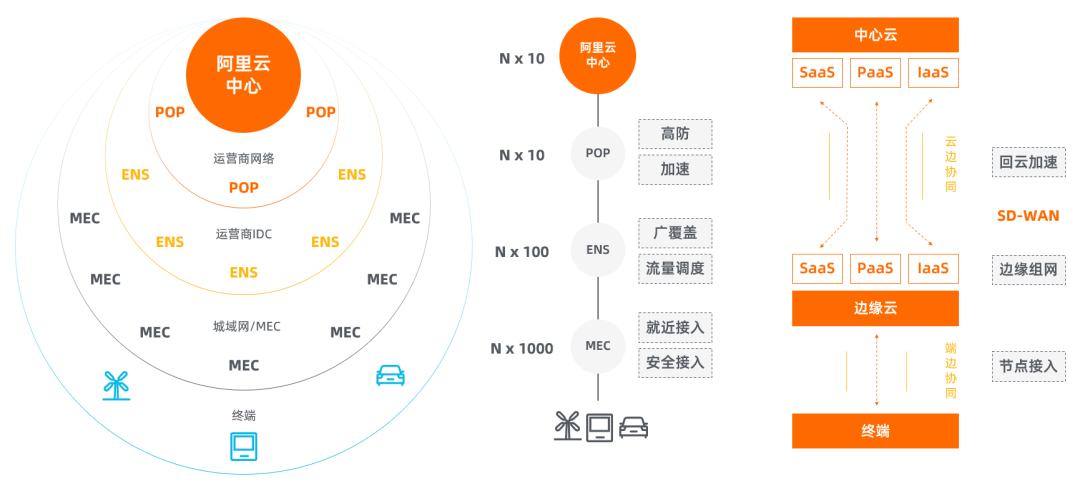
3. Integrated Enhanced Services of 5G Edge Computing
Typically, edge computing is simply equated with IP traffic scheduling. In the 5G era, people may also simply equate UPF to MEC node as pulling an IP data flow to bring over the traffic of interest. However, in reality, edge computing under 5G can do much more.
From Traffic-Oriented to Service-Oriented
The first evolution is from traffic-oriented business enhancement to service-oriented business enhancement. We are pulling over not just traffic, but also the services carried by that traffic, which will give more meaning to the traffic. Therefore, when scheduling, we need to consider the requirements of the services carried by the traffic rather than just the data flow. Thus, edge computing under 5G needs to evolve from being traffic-oriented to service-oriented.
From the perspective of service, if 5G edge computing is merely positioned as a service deployment closer to users, it diminishes the value of 5G edge computing. Beyond the obvious advantage of lower latency from proximity, we need to further focus on and realize service enhancement.
From Closer Services to Stronger Services
Due to the architectural characteristics of mobile networks, compared to traditional fixed networks, mobile networks operate on a dual approach of user plane traffic and control plane management. Edge computing pulls user plane traffic but can also interact with the mobile network to obtain more control plane information, such as SINR and Cell Load data. This control plane data can provide more capabilities for services, further enhancing the external service capabilities of edge computing and even opening up new business scenarios.For instance, while pulling traffic, we can also bring in data on overall cell load and signal strength seen from the control plane. This data can be used by the service side for better congestion control, allowing upper-layer services to adapt to the corresponding wireless environment, thereby further enhancing user experience.
From General Services to 5G Edge Services
Finally, due to the existence of edge computing, the previously prevalent “client/server” architecture on the Internet will transform into a “client/edge/server” architecture. Therefore, we must consider the role of the edge in the overall link and the enhanced services brought by 5G. In the 5G era, the services deployed at the edge cannot merely be a simple nearby deployment of cloud services; they must evolve from general services to 5G edge services. Only in this way can we truly leverage 5G edge computing.
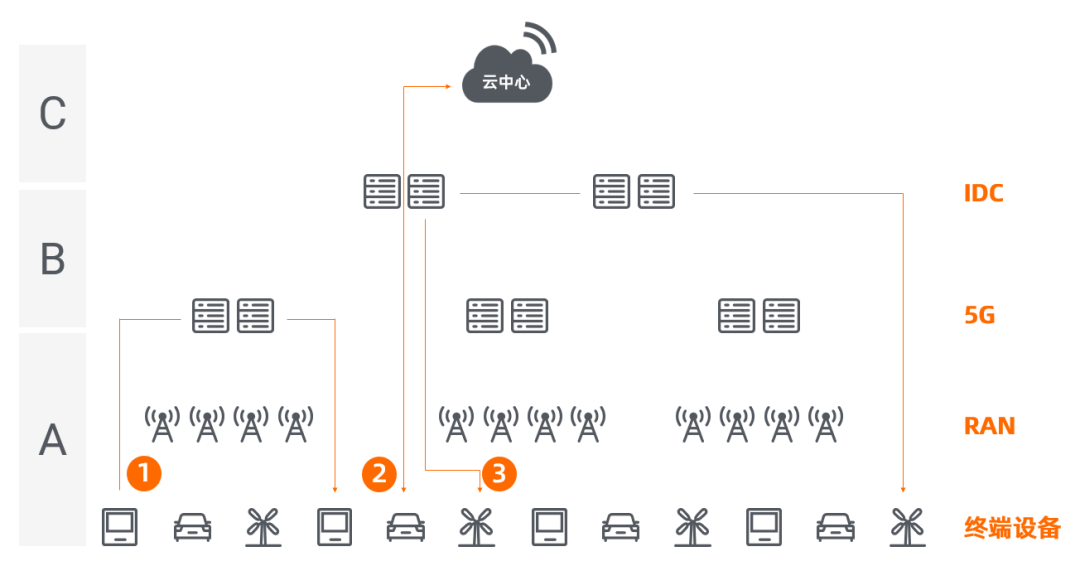
4. From Edge to Centralized Cloud-Network Integration
First and foremost, we emphasize that edge computing is not isolated. We view edge computing as an extension of cloud computing, expanding the boundaries of the cloud. The edge is crucial as a data link between the terminal and the central cloud, forming a “cloud-edge-end” integrated computing model.
The greatest advantage of cloud computing is its scalable computation, which can yield immense cost reduction and efficiency gains. However, concentrating all computing at one point is clearly unrealistic. Besides computation costs, another critical factor affecting the distribution of computing is the cost of data transmission. The “cloud-edge-end” integrated computing collaborative model actually represents a dynamic balance between the transmission costs of data in the network and the benefits of computational concentration. In this model, we continuously innovate network infrastructure and technical capabilities to influence the distribution state of computational concentration.
The core brain of cloud computing consists of dozens of centralized cloud regions distributed globally, providing powerful and efficient computing power based on large-scale concentrated resources. Resource concentration also significantly reduces the cost per unit of computing power, while the average data transmission cost to the terminal is relatively high.
Extending outward from the central cloud are the operator networks, connecting hundreds of operator data centers. This constitutes the first layer of edge computing distribution nodes, providing medium-sized centralized computing power for provincial-level nearby computing and traffic scheduling. At this layer of edge computing nodes, an SD-WAN (Software Defined Wide Area Network) network is built based on numerous widely distributed data centers, responsible for accelerating cloud return and edge-to-edge acceleration, providing “cloud-edge” and “edge-edge” collaborative capabilities, shielding the impact of internet transmission fluctuations between central cloud and edge cloud on business layer data transmission. Compared to the central cloud, at this layer of computing nodes, the benefits brought by computational concentration are relatively smaller, but the data transmission costs to the terminal are significantly reduced.
5G allows edge computing to continue extending down to the operator’s municipal metropolitan area networks, which will eventually connect thousands of MEC nodes. This is the second layer of edge computing distribution nodes, providing small-scale centralized computing power for nearby computing and traffic scheduling at the municipal level. Because MEC nodes are closer to the terminal, lower latency and costs enable more computations that could only be performed at the terminal to be shifted to the edge, thus forming computational concentration and ultimately bringing cost benefits. Moreover, 5G releases more network transmission quality control capabilities between terminals and edges, allowing us to optimize the “end-edge” network service quality based on scenarios, achieving cost reduction without sacrificing user experience.
In summary, through an overall network system from cloud to edge and then to terminal, we form the capability of cloud-network integration, allowing different business scenarios to find the most suitable computational distribution model in this integrated form.
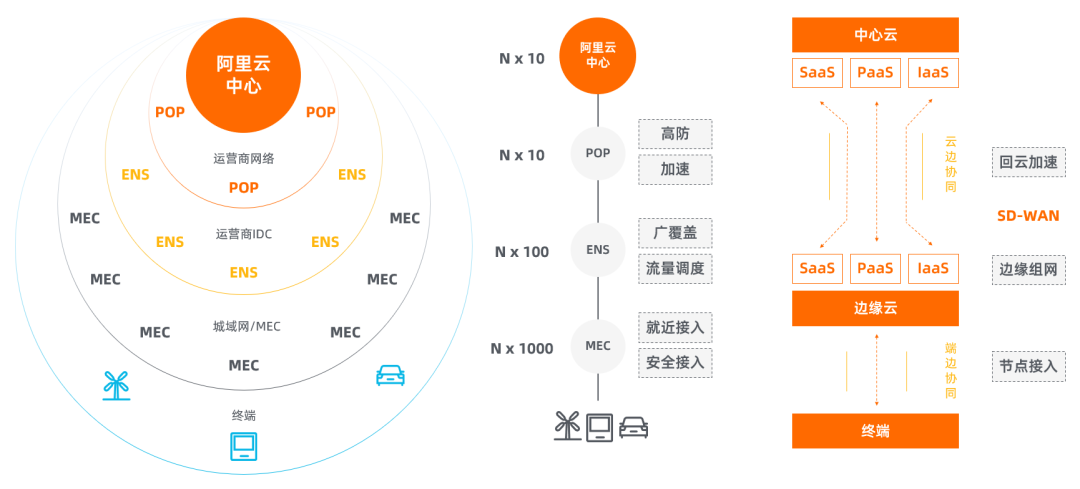
5. Full-Link Unified QoS Control Based on Business Scenarios
In the capability of cloud-network integration, besides cost, the most concerning aspect of business scenarios is network QoS (Quality of Service). Under a long link like “cloud-edge-end”, the QoS strategies used in different segments can vary.
Here are three different data transmission scenarios:
-
Between terminals within local MEC
-
Between terminal and cloud center
-
Between terminals across regions/operators
Breaking down the full-link QoS segments, it can be divided into the following three segments:
-
Within the 5G core network
-
Between MEC and data centers as well as between data centers across different regions/operators
-
Between data centers and cloud centers
Within the scope of the 5G core network/MEC, QoS policy control needs to be implemented based on operators’ 5G capabilities, which can significantly enhance the network quality of the terminal access segment.
In the segment from MEC to data centers, it falls within the scope of the operator’s internet. In this segment, we build an Overlay SD-WAN network based on widely distributed data center resources, thus shielding fluctuations in the internet and controlling business traffic scheduling.
In the segment from data centers to cloud centers, based on the operator’s internet, supplemented by dedicated lines from operators to further improve the network quality of the cloud return transmission link.
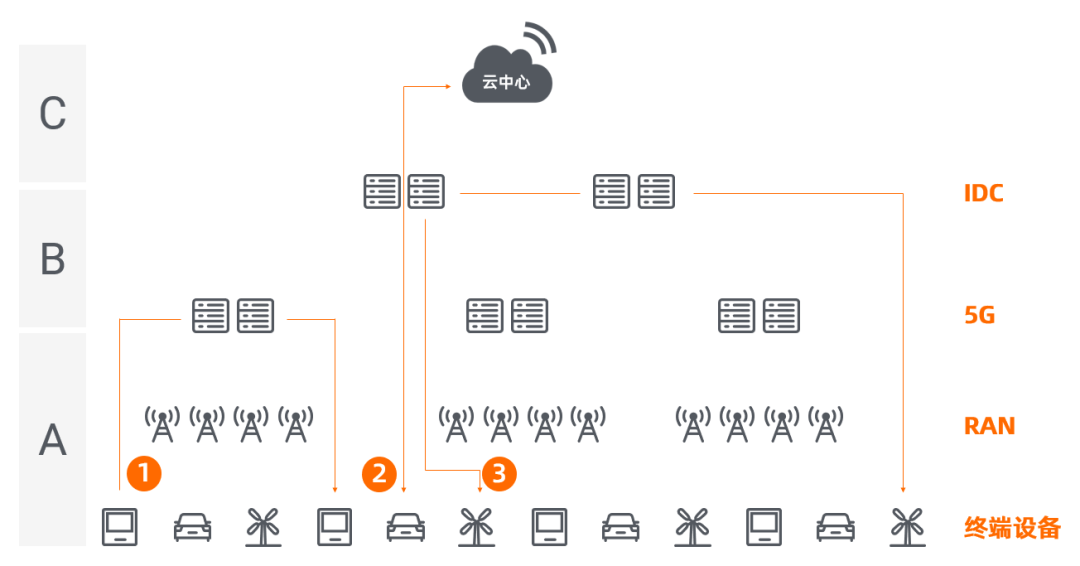
Different scenarios, different combinations of link QoS strategies
Ultimately, integrating the QoS control and scheduling capabilities of these three network segments provides end-to-end full-link unified QoS assurance capabilities for upper-layer business applications, significantly reducing the operational complexity at the business application level.
Edge computing prompts changes in computational forms, making more business scenarios possible, but at the same time, the diversity of computational forms and distributions significantly increases technical complexity. 5G does not merely bring edge computing closer; Alibaba Cloud’s edge computing aims to shield businesses from complex computational distributions and data collaboration, thus helping more business scenarios land in the “cloud-edge-end” integrated computing model, maximizing benefits/costs.
Technical Open Class
Build Your Own Web IDE
A Web IDE allows you to write code anytime and anywhere as long as you have a network and a browser. On a cloud server, you can easily set up your own Web IDE (Visual Studio Code). This course consists of 7 lessons, guiding you from scratch to create your own online development environment using Alibaba Cloud ECS server!Click “Read the original” to start trying!
Click “Read the original” to start trying!
Follow “Alibaba Technology”
Keep Up with Cutting-Edge Technology








